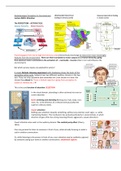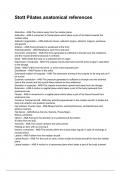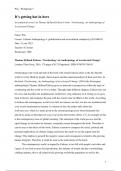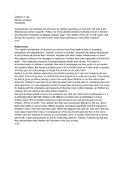Lecture 7: The governance of Cybercrime
Brenner & Clarke, Distributed Security: A New Model of Law Enforcement (2005)
This article examines how and why our current law enforcement model is inadequate and
proposes a new model of law enforcement to deal effectively with cybercrime. This model
suggests that government can better control cybercrime by employing a system of
distributed security that uses criminal sanction to require computer users and those who
provide access to cyberspace to employ reasonable security measures as deterrents.
Law and Order: order has had two complementary aspects:
- External order encompasses a society’s relationship with its physical and biological
environment. Our reliance on the military to deal with external human threats
increased as societies evolved into territorially-based nation-states; territory became
the point of demarcation between external threats and challenges to internal order.
- Internal order is achieved by structuring the relationships and activities to those who
comprise a society in predictable productive ways. They set legitimate social
expectations and establish a baseline of order by defining the behaviors that are
appropriate.
- Law and order through criminal rules prohibitions and sanctions
o Crime is a complex, enduring aspect of human social life; societies accept that
they cannot eliminate it and so strive to control it. Historically, this has been
based on the assumptions that sanctioning those who violate criminal rules:
Expresses societal condemnation of the violations
Exacts punishment for the affront to society
Controls crime by deterring future violations
Includes two subsidiary assumptions:
o Sanctions deter violations by presenting us with a
simple choice – obey rules or suffer the consequences
o Rule violators must be identified, apprehended and
sanctioned.
However, the deterrent effect of punishment is a joint function
of:
o The severity of the punishment
o The likelihood of being punished
Crime
Real-world crime that occurs in a physical environment.
- Proximity
- Scale
- Physical constraints
- Patterns
Cybercrime
- There is no generally accepted precise definition of cybercrime. It can consist of
traditional crimes or new types of criminal activity.
- It does not require physical proximity between victim and perpetrator
- One-to-one victimization is not a valid default assumption for cybercrime because it
can be automated.
Brenner & Clarke, Distributed Security: A New Model of Law Enforcement (2005)
This article examines how and why our current law enforcement model is inadequate and
proposes a new model of law enforcement to deal effectively with cybercrime. This model
suggests that government can better control cybercrime by employing a system of
distributed security that uses criminal sanction to require computer users and those who
provide access to cyberspace to employ reasonable security measures as deterrents.
Law and Order: order has had two complementary aspects:
- External order encompasses a society’s relationship with its physical and biological
environment. Our reliance on the military to deal with external human threats
increased as societies evolved into territorially-based nation-states; territory became
the point of demarcation between external threats and challenges to internal order.
- Internal order is achieved by structuring the relationships and activities to those who
comprise a society in predictable productive ways. They set legitimate social
expectations and establish a baseline of order by defining the behaviors that are
appropriate.
- Law and order through criminal rules prohibitions and sanctions
o Crime is a complex, enduring aspect of human social life; societies accept that
they cannot eliminate it and so strive to control it. Historically, this has been
based on the assumptions that sanctioning those who violate criminal rules:
Expresses societal condemnation of the violations
Exacts punishment for the affront to society
Controls crime by deterring future violations
Includes two subsidiary assumptions:
o Sanctions deter violations by presenting us with a
simple choice – obey rules or suffer the consequences
o Rule violators must be identified, apprehended and
sanctioned.
However, the deterrent effect of punishment is a joint function
of:
o The severity of the punishment
o The likelihood of being punished
Crime
Real-world crime that occurs in a physical environment.
- Proximity
- Scale
- Physical constraints
- Patterns
Cybercrime
- There is no generally accepted precise definition of cybercrime. It can consist of
traditional crimes or new types of criminal activity.
- It does not require physical proximity between victim and perpetrator
- One-to-one victimization is not a valid default assumption for cybercrime because it
can be automated.










